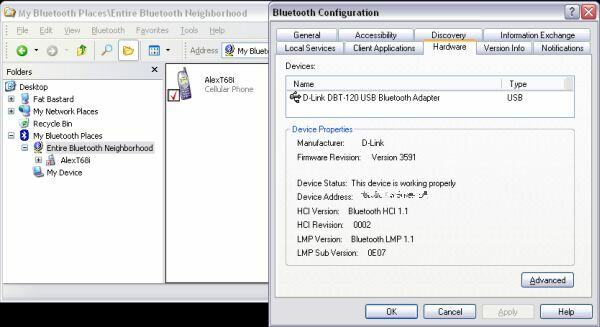| Friendly Expert Computer Help - In Plain English | |||

|
|
|
|
|
|
|
|
|
| PC911 > How-To > Miscellaneous > The Wireless Roadwarrior Experience |
The Bluetooth Adapter: D-Link DBT-120
For some reason, Bluetooth has been extremely slow to gain popularity. It has been in development since 1998, and the current 1.0B spec has been out since December of 1999. Bluetooth is a wireless technology that uses the radio range of 2.45 GHz with a theoretical maximum bandwidth of 1 Mbps. It has a operating range of about 33 feet (10 meters) for typical class 2 or class 3 devices. It has a very low power consumption and does not require a direct line of sight between devices, meaning you can leave the phone in your pocket or sync with your laptop in the other room. The point is to enable instant personal area networks (PAN) to connect up to 8 devices for easy data exchange, e.g. between a laptop, mobile phone, PDA, wireless headset, printer, and more.
Bluetooth offers various degrees of security. It can a) be open and allow any device to connect, b) allow communication only between paired devices that have been associated with each other, or c) require authentication and encryption. To avoid interference, Bluetooth uses a frequency-hop time-division technology, hopping up to 1600 times per second between 79 different channels. The master device in a Bluetooth network (also called piconet) furthermore divvies up time slots for each device to transmit. This method of dividing time slots between multiple devices is called Time Division Multiplexing (TDM).
Bluetooth adapters are now available at affordable prices from many manufacturers, usually in form of PCMCIA cards, USB modules, or access points. I purchased the D-Link DBT-120 for $50 at Fry's. Besides the price I also liked its extremely small size. It is about the size of the top phalange of my thumb.
 |
Microsoft does not offer native Bluetooth support in Windows XP, and there is no driver certification available. From what I understand, Bluetooth support will arrive in Windows XP Service Pack 2.
Installation was extremely easy. I downloaded the latest drivers from D-Link's website (first rule of hardware installation: never use the included CD, it will be outdated the moment you open the box), installed them as instructed, inserted the device into a USB port - done. The result is a new icon on your desktop and in Windows Explorer called My Bluetooth Places, and a new icon in your system tray and in the Control Panel called Bluetooth Configuration. My Bluetooth Places shows all detected or connected Bluetooth devices for easy access to their services. Bluetooth Configuration opens a multi-tabbed panel with numerous configuration options
A search for Bluetooth devices picked up the phone right away and displayed it in the Bluetooth neighborhood, listing all available phone services: Dial-up Networking, Fax, inbox, IrMC Synchronization, and two serial ports. Following the instructions, I paired the laptop with the phone, which means creating a link between the two devices, telling them about each other, and that it is ok to connect and exchange information. This avoids the hassle of having to manually connect the two every single time you want to transfer information between the two.
 |
Because it is a USB device, it is hot-pluggable, meaning you can plug the adapter in whenever you need it, there's no need to have it connected all the time. When plugged in directly into the USB port of a laptop, it is an abnormal protrusion that you have to watch out for and be careful not to break it off. The adapter also comes with a USB extension cable so you can route it from a somewhat inaccessible USB port on the back of a computer to a more accessible area like your desktop.
The device has been working flawlessly, I have not experienced any problems whatsoever with it. Connectivity could always be established on the first attempt without any delay or issues. A reliable device for a good price, it gets a thumbs up.
| Back To Top Of Page | ||
|
[PC911 Home]
[News]
[How-To's]
[Tips & Tweaks]
[Reviews]
[Freeware]
[Best Prices]
[Links] [Search] [About PC911] [Link To PC911] [Support PC911] [Legalese] ©Copyright 1998-2022 PC911 Webmaster |
||